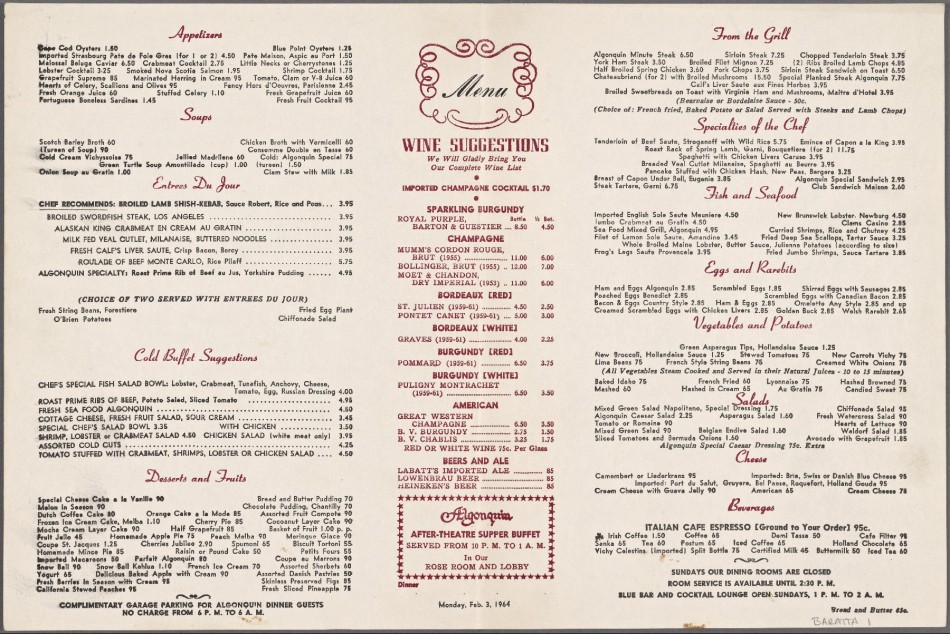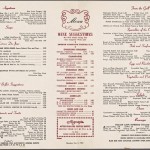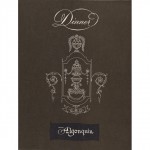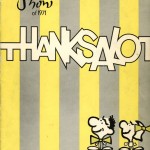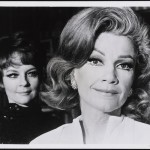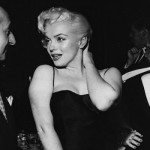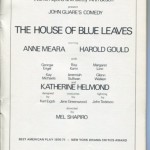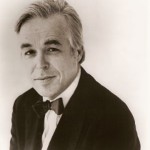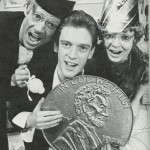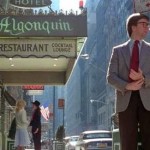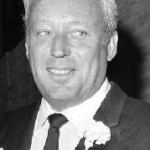by Michael Elihu Colby
(click all photos to enlarge)
Part 15: Excelsior
The storybook aura of the Algonquin had been shattered by my father’s death. Our family questioned whether the fantasies he’d fulfilled there had turned into something of a devil’s pact. Still, there was nothing we could do to change the course of events but honor his memory, be there for each other, and do our best to go on with our lives. In the Jewish tradition, that is the purpose of shiva, our mourning period. With my grandparents making most of the arrangements, mourning went hand in hand with eating—to ease the pain.
Food, be it Jewish or Southern, was always treated as an all-purpose support system in my family. It may not have reversed a situation but it sure made the present a lot more bearable. Growing up on Long Island, no matter how tough or miserable a week, I looked forward to the kitchen magic made by Louise—our housekeeper from Charleston. Best of all were feasts she prepared on Fridays: fried chicken, ice tea, Grandma Mary’s recipe for matzo ball soup, and chocolate pie made with that Jewish-home staple, My*T*Fine pudding.
Once I moved into the Algonquin, the accent on food, if anything, intensified. Grandma Mary’s theme song might have been “As Long as She Feeds Me.” She seemed at her happiest when she could provide my favorite dishes (often taking a bite herself) as if that were the ultimate demonstration of affection. She had regal repasts served to me via Algonquin restaurants and/or room service. It didn’t matter that I was a light and picky eater. She’d make sure I was sated during my college breaks and later during my fulltime occupancy at the Algonquin. Minute steaks, squab stuffed with wild rice, jumbo fried shrimps, Caesar salads, and the pick of the day’s lobsters: these were reserved for me and other family members (Albeit, the shrimps and lobsters weren’t the best training for my future with Andrea, my Kosher-keeping wife). Then there were the after-theatre buffets with hot corned beef and pastrami sandwiches, apricot torte or coconut cake, and the Algonquin’s own variation of Chasen’s chili (I myself never liked chili but all my increasing number of friends did; ditto the hotel’s popovers, roast beef au jus, and Yorkshire pudding).
Even if NY food critics didn’t always rave about the Algonquin menu, I thrived on it. A bonus was visiting Grandma’s home kitchen on the 10th floor. There you might smell the beckoning aroma of her soups. Grandpa Ben could be found at their dining room table, savoring her lima bean or cabbage soup, in which he dipped a heel of pumpernickel. Another favorite was schav, made with eggs, sorrel, and sour cream. A grateful bellman, Will Sawyer, recounted how she’d cook a specialty he’d take home to his very Irish Catholic family at Thanksgiving: “This strange delicious Jewish dish called kugel [noodle pudding].” And then there were her knaidels, which I devoured—with or without soup—like marshmallows. She shared that recipe with me and to this day, my matzo balls can get me through almost anything.
Of course, food could not eliminate the deep shadow that hung over us right after my father’s death. But, there were other occurrences that helped distract. Foremost, not long after the loss, I left my residence at the Algonquin for Evanston, Illinois to start my Sophomore semester at a new college, Northwestern University. American University had given me the confidence and grades to transfer to my first choice college, Northwestern—with its exceptional Drama and Journalism departments. I was particularly enthused at the prospect of submitting lyrics to the Waa-Mu show, N.U.’s celebrated annual revue. During the next couple of months I must have submitted dozens of lyrics for consideration, most of which were rejected (Out of curiosity, I likewise submitted some good—if obscure—lyrics by Cole Porter and Lorenz Hart which were rejected as well). Fatefully, “The Telepathic Twosome”, my one lyric that got into that year’s show, Thanks a Lot, was co-sung by student Michael McCormick, who years later would appear in Charlotte Sweet and topline the Broadway revival of 1776.
Theatrical ambitions were everywhere at Northwestern. Waa-Mu alumni had included Warren Beatty, Cloris Leachman, lyricist Sheldon Harnick, Tony Randall, Walter Kerr, Paul Lynde, and Ann-Margret—to name just a few. Though I knew there were far more skilled performers at Northwestern, I mustered the courage to audition for the Waa-Mu cast, stumbled through the dance combination, and even received a callback. I’ll never forget waiting backstage with other auditioners, including some hyper-histrionic students who were junior versions of types I’d seen at the Algonquin. One was hitting unearthly notes, one discussing her Broadway credits, and another somersaulting—seemingly to intimidate the competition. To calm my jangled nerves, I chatted with one cute girl, Laura Weil, who ended up in the show. Years later, I saw Laura during intermission at Charlotte Sweet and called out her name. She had no memory of me but was cordial. She then proudly stated she now worked at a theatre agency and was visiting to scout leading lady, Mara Beckerman. Then she asked what I was doing at the show, to which I answered “I wrote it for Mara.” I felt, after what I’d seen at the Waa-Mu audition, I was entitled to a little hubris.
Another benefit at Northwestern was its trimester set-up, which allowed me month-long trips back to the Algonquin during the December and March height of the Broadway season. Within those months, it was easier than ever for me to catch up on shows, now that I lived at the hotel—a short walk from the theatre district. One musical I saw three times was Applause, the backstage musical based on my favorite movie All About Eve. It was the perfect lesson in how a musical can evolve from trifle to triumph. Its tryout in Baltimore occurred while I was still at American University, so I took a train from Washington DC and joined Grandma Mary, attending the out-of-town premiere. The premiere was a mishmash of tentative performances, rambling scenes, and hit-miss numbers. Lauren Bacall, playing the acerbic Broadway actress “Margo Channing” was an ideal choice for the role originated in the film by Bette Davis, even if her singing was in its own orbit. But Diane McAfee, a talented young actress, didn’t quite have the command or menace to play Margo’s scheming protégée, Eve Harrington. Perhaps to compensate, her big number “Halloween” —a solo about Eve’s ruthlessness—included an overhead movie of the topless and writhing McAfee that literally exposed the naked truth about her character. Concurrently, my Grandmother was also writhing, seated next to her “innocent” grandson, with an audience expression reminiscent of “Springtime For Hitler.”
Months later, during my Spring vacation, I saw a vastly improved show at its Broadway opening. The book was tighter and funnier, songs had been reworked or replaced, and I witnessed how one performer can transform a show. Actress Penny Fuller had taken over the role of “Eve Harrington” in a performance as dynamic as Bacall’s. At last the musical had an Eve comparable to Anne Baxter in the movie: a dragon lady in the guise of a sweet ingénue. The nude movie projections were gone—there was no need to distract from the brilliance of Fuller’s “bitch showing her claws” rendition of “Halloween” (And I don’t think this decision was just based on someone seeing Grandma Mary’s expression in Baltimore).
But, for me, Applause was at its pinnacle when I saw it for the third time, in January 2001. That’s when Anne Baxter—the original Eve (whom I’d recently met via my friend Dorothy Hart)—succeeded Lauren Bacall as “Margo Channing.” That casting gave the show nuances no other musical can claim. You see, a major reason Anne Baxter was originally cast in All About Eve was her resemblance to the first actress signed to play “Margo Channing”—Claudette Colbert—who dropped out because of a ruptured disc. The intention was to create the illusion that Eve and Margo were younger and older variations of the same persona. With the magnificent Anne Baxter and look-alike Penny Fuller playing opposite each other, that original goal was finally achieved (bliss for a longtime fan of All About Eve).
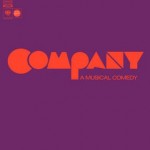

Another highlight of New York, back in 1971, was an off-Broadway play to which Grandma Mary took me because it was co-produced by Warren Lyons, the son of the Bodnes’ good friends, columnist Leonard Lyons and his convivial wife, Sylvia. The Lyons’ were another pair of friends whose close acquaintances were a Who’s Who of cultural greats, including Moss Hart, Ernest Hemingway, Charlie Chaplin, Orson Welles, and Dorothy Parker.
Warren Lyons was not only a producer but a first-rate pianist-singer who’d lived, for a time, at the home of Ira Gershwin.2 The up-and-coming playwright whom Warren Lyons championed would soon have his own award-winning position in American culture: John Guare, his play The House of Blue Leaves. Among the first of numerous awards the play received, was the New York Drama Critics citation as “Best American Play,” presented at the Algonquin. John Guare became a fixture visiting the Algonquin, always kindly and enthusiastic to members of my family. He would win two other New York Drama Critics Awards: for Two Gentlemen of Verona (which also won the Tony as “Best Musical”) and for Six Degrees of Separation (“Best Play”).
In 1974, he wrote a play of special interest to my family, Rich and Famous, which Grandma Mary and I attended as Guare’s guests at the N.Y. Public Theater. We eagerly awaited the show, directed by Mel Shapiro (who’d helped make House of Blue Leaves a classic) and featuring the virtuoso cast, William Atherton (also from House of Blue Leaves), Ron Leibman, and Anita Gillette (my favorite “Sally Bowles” in Cabaret). The show was a droll comedy about the tribulations of a New York playwright. However, within 15 minutes of the play’s start, something happened as disconcerting as Grandma’s expression during the topless scene in Applause. Conspicuously and audibly, Grandma Mary was snoozing. Now, this was not unusual for Grandma. She visited the Land of Nod at movies, matinees, opening nights, you name it. But, after all, we were John Guare’s guests, it was a small theatre, and—for all I knew—Guare might have been there to spot us. So I sat there, trying to focus on the show and praying for the best. Then the reason we’d been invited to the show in the first place became obvious. William Atherton, as playwright Bing Ringling, picked up a phone and delivered the line “Hello??? Algonquin Hotel?? I’d like to leave a message…”3
All it took was that word “Algonquin” to bring Grandma to her senses. Out of a sound—accent on “sound”—sleep, Grandma sprang upright, exclaiming for all to hear, “Who said ‘Algonquin’?! Who said ‘Algonquin’?!” I had to subdue her, as the play shifted to a scene set “outside to the left of the fabled Algonquin Hotel.”4 John Guare’s scene not only featured the hotel but mentioned its name several more times. Now Grandma was at full attention. She watched, beamed through the scene, and, upon its completion, returned to the Land of Nod—while I (despite all this) enjoyed the show.
Coincidentally, Rich and Famous was also the name of a 1981 George Cukor film that featured scenes at the Algonquin Hotel (It’s where Jacqueline Bisset, as a famous writer, conducts an affair with a reporter from Rolling Stone [Hart Bochner]). Other movies in which the hotel is spotlighted include such now forgotten titles as Wives and Lovers (the 1963 Van Johnson film which at least produced a famous Burt Bacharach title song), Fitzwilly (1967 with Dick Van Dyke), and They All Laughed (1981 Peter Bogdanovich film with Audrey Hepburn & John Ritter).
Surrounded by the “Rich and Famous” at the Algonquin, I naturally daydreamed of a time I might be “rich and famous” on my own. Back at Northwestern U., particularly in the drama department, I was surrounded by students with even stronger ambitions than I’d ever possess. Nonetheless, I persisted. Even if most of my lyric submissions at Waa-Mu were rejected, there was always another project to which my hopes were pinned. It was the musical I was writing with my brother Douglas as composer—based on the movie The Wrong Box—even though we neither had the rights nor were old enough, at 19 and 16, to be taken completely seriously.
Meanwhile, in 1971, there was a truly rich and famous Algonquin guest whose credentials assured his getting produced, although his one musical was received in a way for which no writer would bargain. Leon Uris was one of the most successful American novelists of his time, with a series of best-sellers including Battle Cry, The Angry Hills, Mila 18, Topaz, QB VII, and Trinity. His most famous book was Exodus, the epic about the birth of Israel that was translated into more than 50 languages and became the biggest seller since Gone With the Wind. Uris was a self-educated author who never graduated high school, yet parlayed his experiences in the Marines and such countries as Palestine into a multi-million dollar fortune. 5 He was so fond of the Algonquin, it became where he held his third wedding—to photographer Jill Peabody—in a lavish Jewish ceremony. I got to watch their Rose Room reception from the sidelines.
Shortly after the marriage, Uris was approached about turning Exodus into a musical with the hope it would be the greatest Jewish-style hit since Fiddler On the Roof. Certainly, “This Land Is Mine”—the theme from the film Exodus by Pat Boone and Ernst Gold—had been a smash. The musical would be titled Ari, taken from the name of the book’s protagonist Ari Ben Canaan, a leader in the movement to establish Israel. According to Uris’ biographer, Ira B. Nadel:
Uris had always loved the theatre, hoping, from his youth, to be a dramatist. His productions in the marines had furthered that desire. Although his career as a novelist and screenwriter flourished, he still wished for a Broadway success.6
In fact, back at the age of 6, Uris wrote an operetta inspired by the death of his dog.7 However, he lacked the requisite experience to write the book and—especially—lyrics for this new musical. The problem was compounded by his choice of composer, Walt Smith, “a musician and restaurateur” whom Uris knew from Aspen. Uris had chosen Smith after admiring the special wedding march Smith wrote for the Uris’ marriage ceremony—sweet, but not model credentials for Broadway.
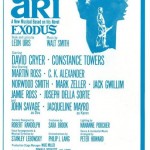

In the aftermath, I suspect Grandma Mary tried her usual means of cheering people up: she sent Leon Uris all kinds of Algonquin comfort food—except turkey (which would have been too symbolic). The experience was yet another Algonquin illustration of the vagaries of theatre that would sharpen my perspective on events to come.
Next part: Coming Attractions
1Lyons. Jeffrey. Stories My Father Told Me: Notes From “The Lyons Den”. New York: Abbeville Press, June 2011.
2Lyons. Jeffrey. Ibid.
3Guare, John. Rich and Famous. New York: Dramatists Play Service Inc. 1977.
4Guare, John. Ibid.
5Liukkonen, Petri. “Leon (Marcus) Uris (1924-2003)” from Books and Writers, rights reserved by Petri Liukkonen (author) & Ari Pesonen. Kuusankosken kaupunginkirjasto 2008: http://www.kirjasto.sci.fi/uris.htm.
6Nadel, Ira B. Leon Uris: Life of a Best Seller. Austin, TX: University of Texas Press, September 24, 2010.
7Nadel, Ira B. Ibid.
© 2014, Michael Colby
***Visit The Museum of the City of New York online : http://collections.mcny.org/
*No copyright Infringement Intended. For Entertainment Purposes Only.
Click Below for Parts 1 thru 14 :
https://www.theaterpizzazz.com/algonquin-kid-part-way-back/
https://www.theaterpizzazz.com/algonquin-kid-part-2-algonquin-renaissance/
https://www.theaterpizzazz.com/algonquin-kid-part-3-series/
https://www.theaterpizzazz.com/algonquin-kid-part-4-series/
https://www.theaterpizzazz.com/algonquin-kid-part-5-series/
https://www.theaterpizzazz.com/algonquin-kid-part-6-series/
https://www.theaterpizzazz.com/algonquin-kid-part-7-mazel-tov-robert-f-kennedy/
https://www.theaterpizzazz.com/algonquin-kid-continues-part-8-series/
https://www.theaterpizzazz.com/algonquin-kid-part-9-british-staying/
https://www.theaterpizzazz.com/algonquin-kid-musicals-r-us-part-10/
https://www.theaterpizzazz.com/algonquin-kid-learning-ropes-part-11/
https://www.theaterpizzazz.com/algonquin-kid-doesnt-happen-holiday-inn-part-12/
https://www.theaterpizzazz.com/algonquin-kid-part-13-series/
https://www.theaterpizzazz.com/algonquin-kid-moving-days-part-14/


